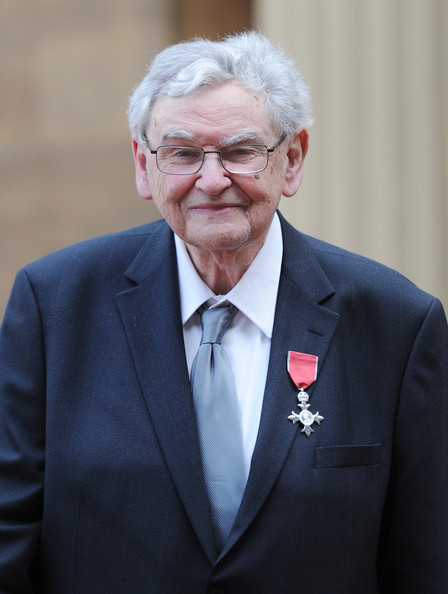Geofrey
Ashe
March 29, 1923 - January 30, 2023
On October 7 2023 the author and cultural historian Geoffrey Ashe was brought to his final resting place in the monastic cemetery chapel’s Columbarium at St Bernard Abbey in Cullman, AL. Abbot Marcus Voss OSB presided, in the presence of family and members of the monastic community. The urn was carried into the Abbey Church for Mass by his step-daughter Leah Chandler, and into the Columbarium chapel by Br Benedict Dyar, Oblate Master at St Bernard. A devoted Catholic, he was a tertiary of the Carmelite priory at Aylesford in Kent (England) in the 1950s, and became an Oblate of St Benedict at Downside Abbey in Stratton-on-the-Fosse (England) in 2004.
He died peacefully at his home Chalice Orchard in Glastonbury, England, on January 30 2022. His wake service and requiem Mass at the Shrine of Our Lady of Glastonbury were conducted by Canon Alan Finley and concelebrated by Bishop Crispian Hollis. Mass was followed by a procession up Magdalene Street and the High Street. A reception took place in the Glastonbury Town Hall. His remains were cremated the following day.
In 2012 he was honoured by the Queen by being elevated to membership in the Order of the British Empire. His MBE commendation cites “For Services to Heritage”. Shortly thereafter, he became the second person in the history of Glastonbury to be named Honorary Freeman of Glastonbury, an honour which he especially treasured because it was given by his own townspeople. That same year he was honoured by the International Arthurian Society by being named “Eminent Arthurian”.
Born on March 29 1923 in London, his education included St Paul’s School in London, the University of British Columbia in Vancouver, Canada, and Trinity College Cambridge in England, also the alma mater of one of his most admired authors, John Milton. His family moved to Canada briefly during World War II, where after graduation from UBC he worked in British Intelligence in Pacific theater in code-breaking, comparable to work at Bletchley Park in England.
An avid reader with a photographic memory, he was strongly influenced by the works of G K Chesterton, whose Short History of England sparked his interest in Glastonbury and its Arthurian connections. An encounter in the Toronto Public Library with a small book Glastonbury and England by Christopher Hollis, drew his attention to the long and venerable history of Glastonbury. He credited it with clarifying his life’s work: to study and write about that history and all it signifies. His first book King Arthur’s Avalon: The History of Glastonbury appeared in 1957 and stirred much public response. Through it and other studies in British and Arthurian history, he “turned Arthurian studies on its head”, according to one critic. The Camelot Research Committee (1965-70), which he co-founded with the eminent archaeologist Dr Ralegh Radford, examined the hillfort at Cadbury Hill, Somerset, long said by locals to be the headquarters of King Arthur. Their confirmation of this has never been refuted. But it was not the medieval romance version of Arthur that was the focus: it was the historical 5th-century High King of the Britons, who was the original on whom the romances were later based. The story of the excavations and the Riothamos named Arthur is recorded most fully in The Discovery of King Arthur. He taught as a Visiting Professor Arthurian studies at many American universities beginning in 1980, and was much in demand on both sides of the Atlantic for lectures, interviews for radio, TV, or newspapers, and was a popular host of groups at Glastonbury Abbey, for both a lecture and a tour of the grounds where he and Dr Radford had excavated the original place where the 12th century monks found the burial site of the historical King Arthur.
He was author of 27 books, many of which are still in print and/or available through the Geoffrey Ashe Histories series in Kindle and Audible books. Many are on topics of British and other mythology, including Arthurian. He often said of myth and legend, that they are not to be believed literally, but that there was a “root of truth” in there somewhere. He found American legends like Paul Bunyan delightful.
He often reminded his listeners that he was not an “Arthurian monomaniac”. His accounts of the voyages of St Brendan the Navigator in Land to the West (1962) earned him an invitation to become a life-long Fellow of the Royal Society of Literature. His biography Gandhi: A Study in Revolution (1972) earned an invitation to serve on the Gandhi Centenary Committee, chaired by Lord Mountbatten. When a publisher mentioned that there was no credible history of the 18th-century Hell-Fire Clubs, he took on the task and produced Do What You Will: A History of Anti-Morality (1974), which spans the period from Rabelais through Hugh Hefner. His lifelong interest in mythology produced Mythology of the British Isles (1990), and Dawn Behind the Dawn (1992, republished later as Eden in the Altai). He advised aspiring authors to write something every day, as he did throughout his long life, until 2 weeks before his death at 98. His last work The Mythology of Creation will be published posthumously.
He was preceded in death by his first wife and mother of his children Dorothy Irene Train Ashe, and his parents Arthur William and Thelma Ashe.
He is survived by his wife of 24 years and literary executor Dr Patricia Chandler Ashe, his step-daughter Leah Chandler, both of Florence, and in England by his children Thomas (Lynda), John (Aileen, deceased), Michael (Cathy), Sheila McGivern (Chris), and Brendan (Miranda), 10 grandchildren, and 16 great-grandchildren.
No services listed.
Donations to the Family
We need to talk about donation portals to the families.
Send Flowers
Here is where we can preview the floral site and take orders directly.

